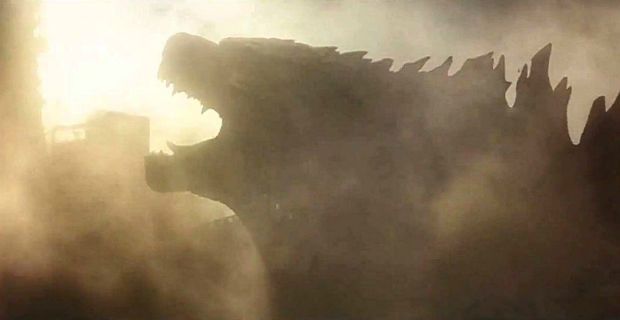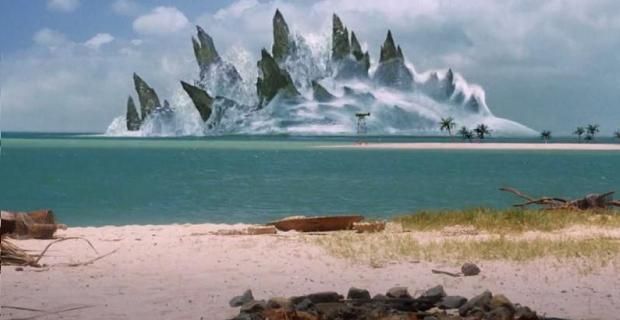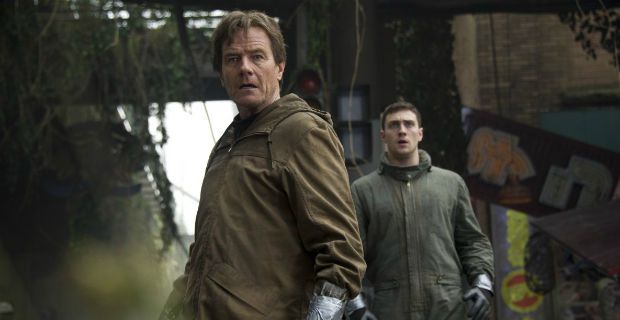Sixty years have passed since Ishirô Honda's sci-fi/horror classic Godzilla (a.k.a. Gojira) tapped into the emotional aftermath of the Japan atomic bombings in WWII. Honda's film ended up giving rise to a immensely popular giant monster franchise - one which has descended very deep into the realm of cornball B-movie entertainment over the decades since then, for good and bad.
It's fitting, then, that director Gareth Edwards will unleash his reboot of the property this year, as the movie seeks to restore the eponymous Kaiju' original image - as a genuinely menacing and terrifying force of nature, albeit for moviegoers in the new century. Trailer footage released from the new Godzilla has certainly painted a promising picture of the final outcome, as has Edwards' palpable enthusiasm about the project (something that was apparent in his original 2012 Comic-Con appearance and the interviews that he's done since then).
Edwards hosted a special screening of Honda's original 1954 Godzilla movie at the 2014 South by Southwest (SXSW) Film Conference and Festival, which was followed by the showing of previously-unreleased material from the 2014 reboot. Some of the footage had been screened before at the movie's 2013 Comic-Con panel, but much of it was new to the public - that includes the portion of the film's official score composed by Alexandre Desplat (Argo, Grand Budapest Hotel) that accompanied it.
You can read the point-by-point breakdown of the new Godzilla material over at STYD, but the shorter and non-spoilery version is that the footage struck the same intense tone and apocalyptic mood as the film's trailers, by heightening the sheer terribleness of its namesake - through a realistic depiction of exactly what kind of impression it would leave on the landscape (city, nature) in its wake.
Moreover, the audience got a glimpse at another Kaiju, which has been teased since the original Godzilla conceptual trailer was shown at the 2012 Comic-Con. (In case you missed it, be sure and read our list of the Other Monsters That We Could See in the Godzilla Reboot.)
The physical design of Godzilla in Edwards' film has made for an interesting discussion topic, with regard to how it both pays homage to the creature's look in Honda's 1954 film - a monster played by an actor dressed in a (by today's standards) unrefined costume with stubby jawline and hefty "cankles" - yet, updates and tweaks the monster's appearance, so that its seems more convincing to the human eye. Edwards talked about the challenges of changing up Godzilla's facial characteristics, during his SXSW interview with STYD:
If you're not careful, you'll wind up with something cute. For me, the thing that stopped it from getting cute was getting a bit more angular. Get it a bit more squarer. A bear, a Grizzly, had that effect, but the eyes didn't look right. One of my favorite images from film design is The Dark Crystal. This book I have has a full page of eyes for the Skeksis. They have these cheekbones or eye sockets that stick out, and I said let's start looking at birds of prey and vultures. There's a nobility you get when animals have the brow of their forehead go to their nose or beak. That was a character trait that felt right for Godzilla. It was a long journey. From the day we started drawing to the day we locked his design was a year. I thought it was going to be a week's work. [laughs]
Judging by the initial footage of the lumbering beast in motion (or merely standing by, admiring its handiwork), that year of careful work has paid off handsomely for Edwards and his Godzilla effects/arts department crew. Part of the reason this matters is because the film is embracing the popular trend in Hollywood of " gritty realism" - by striving to imagine what could actually happen, were a Godzilla somehow able to exist and wreak havoc in the real world today.
On the other hand, as Edwards pointed out, that's far from being a brand-new concept:
I think it's really underrated and Godzilla is misunderstood in terms of how it all began. People think of Godzilla and think of child-friendly versions. It's funny because people look at the '60s films, they're a bit B-movies and people can say, what if you made it serious like the Batman series became? And if you look at the original, they did that already. They beat us to it by 60 years, it's really serious and somber and very harrowing. Apart from the fact there's a giant monster, I challenge you to show me a film – like a popcorn movie – where they show a child and they hold a Geiger counter and it clicks as if the child is going to die of radiation sickness and the shot moves on. I have not seen that in films of real dramatic weight, let alone a monster movie. I can't think of a more serious monster movie.
During that same interview, STYD cited Steven Spielberg's 1970s alien drama Close Encounters of the Third Kind as a similar classic genre movie that, much like the 1954 Godzilla, is very socially-conscious and sophisticated in its realistic handling of fantastical material, which Edwards agreed with:
I think that movie is a perfect example of the film I love. Close Encounters was referenced a lot on this, because we have a conspiracy thread in our movie and they get it right. That movie is a great example of doing it right and not putting one foot into cheese. Close Encounters, I think, is one of the best movies ever made and has influenced me as a filmmaker. I think when you see it, I never claimed to make a movie as good as Spielberg ever did, but Close Encounters has infected Godzilla quite a bit.
Godzilla costar Bryan Cranston (Breaking Bad) also previously noted the Spielberg influence on Edwards' Godzilla reboot, specially with regard to how Jaws portrays its "monster" - and, by association, what effect the shark has on the lives and behavior of the human characters within the film's narrative.
Similarly, Edwards previously referenced that very "conspiracy thread" that he mentioned in his SXSW interview during his breakdown of the full trailer. To be exact, the most recent theatrical preview alludes to a government conspiracy/coverup subplot that is also further grounded emotionally through a personal tragedy story - one that involves the father-son duo played by Cranston and Aaron-Taylor Johnson (Kick-Ass 2). "Spielbergian" feels like all the more appropriate (and welcome) a description, in that sense.
__________________________________________________
Godzilla arrives in U.S. theaters on May 16th, 2014.



